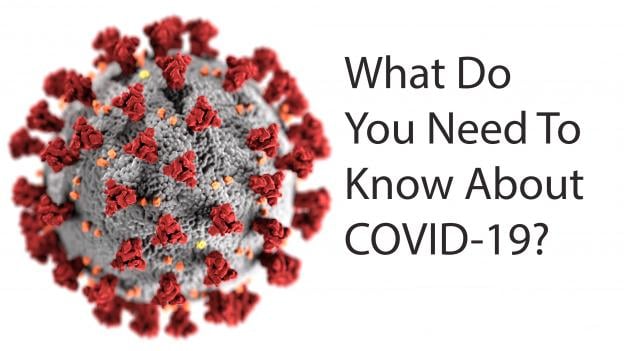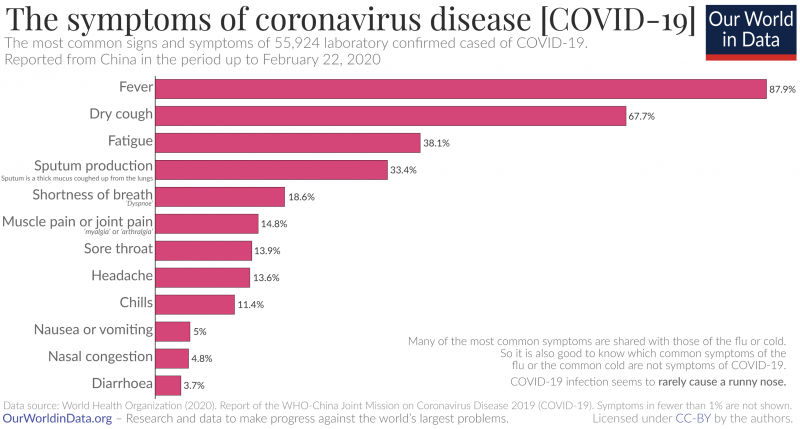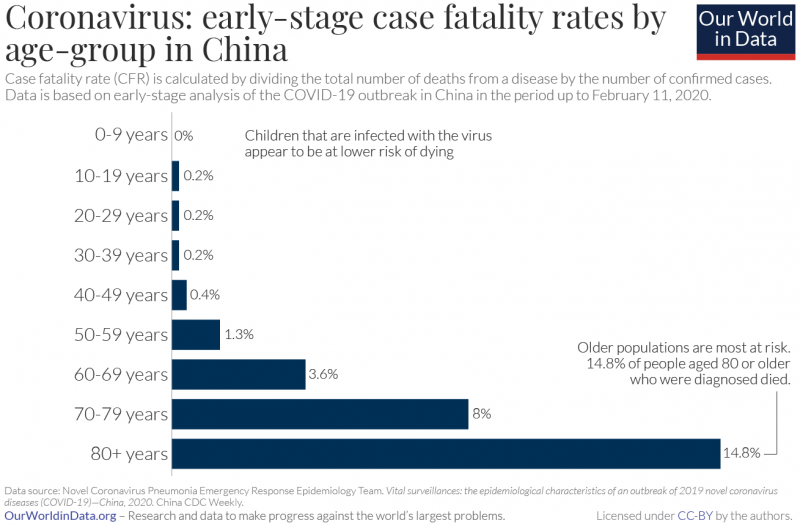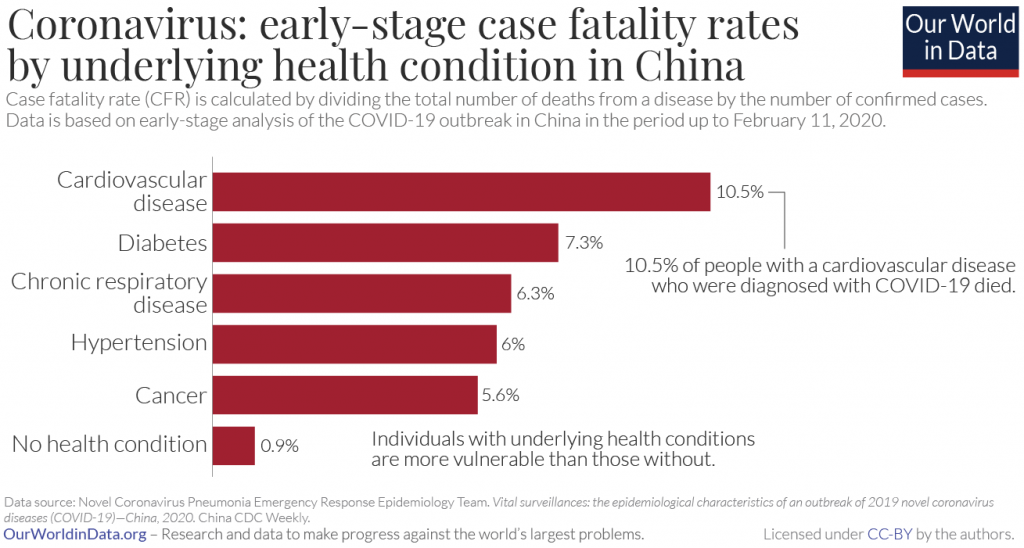Toggle navigation

Coronaviruses are a large family of viruses that cause fever and respiratory illnesses in humans. These viruses circulate in animals and some of them have the ability to transmit between animals and humans. Coronaviruses cause up to 30% of the common colds in human beings.
Coronavirus disease 2019, abbreviated as COVID-19 is a respiratory illness caused by a new Coronavirus that was first reported in Wuhan city of China. Since the time of its discovery in Wuhan, the new Coronavirus has triggered a global health crisis, infecting around 183,738 people and killing around 7,180.
In the past, these Coronaviruses have caused other epidemics such as Severe Acute Respiratory Syndrome (SARS) in 2003 and Middle East Respiratory Syndrome (MERS) in 2012.
The symptoms commonly reported in patients of COVID-19 include mild to severe respiratory illness, fever and dry cough. More often than not, these symptoms are mild and may appear 2-14 days after exposure.
So far, around 90% of the reported cases have been found to have fever and 70% have dry cough. Another common symptom, fatigue has been found in 40% of the patients. Sputum production was reported in every third person.
Other common symptoms include muscle pain or joint pain, sore throat, headache, chills, nausea, vomiting, nasal congestion and diarrhoea.
Below is a chart depicting the common symptoms of Coronavirus infection along with the percentage of patients in which they were found:

Incubation period refers to the time between exposure to an infection and appearance of its first symptoms. For COVID-19, the incubation period ranges from 1 to 14 days, most commonly around 5 days.
COVID-19 lasts for 2 weeks on an average.
According to a study by the WHO, the time from the onset of symptoms to clinical recovery has been around 2 weeks for mild cases. For critical cases, this figure hovers around 3 to 6 weeks. In cases where the patient died, the time from onset to death has been around 2 to 8 weeks.
The following groups of people are at a high risk of falling very sick from COVID-19:
As far as the risk of dying from COVID-19 is concerned, it is still not very much known to researchers. All they can do is rely on certain metrics to gauge how fatal this illness can be.
One of the key metrics is the case fatality rate (CFR) or the proportion of deaths from COVID-19 compared to the total number of people diagnosed with it for a period of time.
CFR (%) of COVID-19= Number of deaths from COVID-19/Number of confirmed cases of COVID-19*100
What’s important to note is that measuring CFR comes with a range of challenges. The first challenge is that the total number of confirmed cases is less than the actual number of cases because many cases have gone undiagnosed. The reasons could be plenty-people with mild symptoms don’t get themselves tested and not every sick patient visits a hospital. Plus, testing facilities are available in limited locations.
Besides, there cannot be a single CFR for any illness and COVID-19 is no exception. It changes with both time, location and population. The fatality rate is dependent not only on the disease but also on the individual and social response to it-the level and timing of the treatment received and the ability of the individual to recover from it.
So, the CFR for an illness can change over time and is dependent on the characteristics of the infected population: age, gender, medical history and so on.
Now, let’s have at a look at the CFR of COVID-19 on different parameters: location, age and underlying health conditions.
CFR of COVID-19 by Location
Here are the CFR figures for COVID-19 calculated up to 15 March 2020:
CFR Globally: 3.7%
CFR in China: 3.9%
CFR in the Rest of the World: 3.5%
As we have discussed above, these figures will continue to change. The figures are higher than the earlier estimates of 2% calculated in early February. This not necessarily mean that the situation has aggravated. CFR usually rises during an outbreak as more cases of the disease get identified and reported.
CFR of COVID-19 by Age
While the aforementioned CFR figures indicate the overall severity of the disease, they don’t tell us which age groups are more vulnerable to infection. Only by understanding the relative risks to different age groups, we can reallocate the resources in such a manner that high-risk groups are benefitted the most.
From what has been observed so far, older persons, particularly 70 or older are at the highest risk of dying if infected.
As per the data gathered from China, 15% of the people in the age group 80+ who were infected died while 8% of the people in the age-group 70-79 years who were infected succumbed to the illness.
One major reason why the elderly are at the highest risk is that they are the ones most likely to have chronic illnesses such as diabetes, cardiovascular diseases and respiratory illnesses.
Another point worth consideration is the high disparity in the fatality rates of young children and elders-only 0.2% of those diagnosed in each of the age groups-10-19, 20-29 and 30-39-have died while 3.6% in the age group 60-69, 8% in the age group 70-79 and 14.8% in the age group 80+ have succumbed.
An age-wise break-up of the CFR has been depicted in the chart below:

CFR of COVID-19 by Underlying Health Conditions
The early data gathered from China suggest that those with underlying health conditions are more likely to die from COVID-19 infection.
As per a study based on the data obtained from China, more than 10% of the people with a cardiovascular disease who were diagnosed with COVID-19 died. High fatality rates were also observed in people with other underlying diseases such as diabetes, chronic respiratory illness, hypertension and cancer. In contrast, the CFR among patients with no pre-existing health condition was a paltry 0.9%.
Here is a chart showing the break-down of CFR by underlying health conditions:

Researchers across the globe have conducted studies comparing the case fatality rates (CFR) of COVID-19 with similar illnesses such as seasonal flu, SARS, MERS and Ebola. Here is a table showing the comparison:
|
Disease |
Estimated CFR |
|
Seasonal Flu |
0.1% |
|
SARS |
10% |
|
MERS |
34% |
|
Ebola |
40% (2013-16 Outbreak) |
While it’s true that COVID-19 is similar to seasonal flu, they are some key differences. Let us have a look at these differences:
Case Fatality Rate: The global fatality rate of COVID-19 has been reported to be around 3.7%. This is remarkably higher than that of seasonal flu-0.1%. That there is no vaccine or effective treatment for COVID-19 makes matters worse.
Contagiousness: COVID-19 is around twice as contagious as seasonal flu. While seasonal flu infects, on an average, 1.3 new people for each patient, COVID-19 infects 2-3 people.
Symptoms: Here is a chart showing the comparison of the symptoms of COVID-19 and seasonal flu:
|
Symptom |
COVID-19 |
Seasonal Flu |
|
Fever |
Common |
Common |
|
Cough |
Usually Dry Cough |
Usually Dry Cough |
|
Fatigue |
Sometimes |
Common |
|
Aches and Pain |
Sometimes |
Common |
|
Runny Nose |
Rare |
Sometimes |
|
Sore Throat |
Sometimes |
Sometimes |
|
Diarrhoea |
Rare |
Sometimes |
|
Headaches |
Sometimes |
Common |
|
Breathing Difficulty |
Common |
No |
The test for Coronavirus is similar to the test done for flu. First, the doctors collect a specimen from the suspected patient, store it in a sterile tube and send it to a laboratory equipped with testing kits. The lab technicians use a procedure called RT-PCR or reverse transcriptase-polymerase chain reaction to identify the presence of Coronavirus genome in the specimen. If the specimen contains Coronavirus, then the genetic material of the virus will be amplified and the person will be tested positive.
The Coronavirus COVID-19 outbreak appears to have originated from a seafood market in Wuhan, China where both live and dead animals are traded. Coronaviruses are known to get transferred from animals to humans. So, in seafood markets, where hygiene standards are difficult to maintain and where animals are densely packed, the risk of infection is particularly high.
It is believed that a group of stallholders in the Wuhan market contracted it from animals.
Interestingly, scientists at the Wuhan Institute for Virology have released a paper which claims that the genetic makeup of the new Coronavirus is 96% identical to the Coronavirus found in bats. So, bats could be the original hosts for the virus. While bats were not being sold at the Wuhan market, they could have infected the animals sold there.
The Wuhan market was closed for inspection and cleaning in early January, but by then the infection had spread beyond the market.
Some early cases of Coronavirus were found in people with no link whatsoever to the Wuhan market, so there could have been cases elsewhere that pre-date the Wuhan case.
In India, the first case of Coronavirus infection was detected in Kerala on January 30, 2020. Majority of the cases discovered subsequently had a recent travel history to countries like Italy, China and Iran, where the disease had reached dangerous levels.
Out of the first 50 cases reported in India, 39 had recently travelled abroad while 10 had come in contact with someone who had travelled abroad. Of the 39 who had travelled abroad, 23 had been to Italy, 7 to the USA and Dubai combined, 4 to Iran, 3 to China, 1 to Thailand and 1 to Oman.
The first three patients of COVID-19 were reported in Kerala, all three of these had returned from Wuhan, the epicenter of Coronavirus infection. The next two cases were reported in the first week of March; out of these two, one had travelled to Italy and the other to Dubai.
As on the day of writing this article, the number of Coronavirus cases in India has jumped to 139 including three deaths.
In India, the government has undertaken several measures at both central and state level to tackle the spread of the pandemic. Here are a few of these measures:
Restrictions on Foreign Travel: The government has suspended all existing visas till 15 April 2020. The only exception are diplomatic, official, international organizations, employment and project visas. All international passengers have to undergo a mandatory screening to detect symptoms of COVID-19.
People have been advised not to travel unless absolutely necessary. Indians who have visited seven countries-China, Italy, Iran, South Korea, Spain, France and Germany-on or after 15 February 2020 will be quarantined for 14 days. COVID-19 certificate has been mandated for Indians returning from Italy or South Korea.
Closure of Public Places: In wake of an advisory issued by the Health Ministry of India, all schools, colleges, gyms, swimming pools and other public places have been closed till March 31 2020.
Restrictions on Large Gatherings: In Karnataka, the state that reported first death due to Coronavirus, large gatherings have been banned for a week. In Delhi, all schools, colleges, cinema halls, gyms, weekly bazaars, night clubs, pubs and spas have been closed till March 31 to contain the Coronavirus infection.
Sanitization Measures: Across the country metros, buses and railways coaches are being sanitized regularly and thoroughly. Mass sanitization of buses is being carried out at bus terminals in Delhi and elsewhere. Central and Western railways have withdrawn curtains from all air-conditioned coaches in a bid to contain the infection. Railway authorities are sanitizing all coach fittings that are regularly touched by passengers.
Offices shut, offering work-from-home: In the wake of the Coronavirus scare, corporates are taking measures to protect their employees. While some of them have closed offices and asked employees to work from home, others have put restrictions on non-essential and international travel. Many of these organizations are sanitizing office spaces, putting sanitizers at entry and exit points, restricting physical meetings and distributing masks among employees.
The first thing you need to do is to keep yourself updated on the latest information related to COVID-19 through reliable health websites and public health authorities.
You can reduce the chances of getting infected by taking some precautions:
Wash Hands: Wash your hands regularly using either alcohol-based hand rub or soap and water.
Disinfect: Use a virus-killing disinfectant to clean all frequently-touched surfaces such as door handles.
Avoid touching nose, mouth and eyes: Your hands are a big source of infection. They can pick up viruses and transfer the same to nose, mouth and eyes from where they can enter your body.
Follow Respiratory Hygiene: Cover your mouth and nose with elbow or tissue while coughing or sneezing. Dispose of this tissue immediately. Because the virus spreads through droplets, following these measures will protect people around you from all kinds of common viruses, including COVID-19.
Maintain Distance: Maintain at least one meter distance from anyone coughing or sneezing. This is because a person coughing or sneezing can spray droplets that contain viruses. If you are too close to the person, you can inhale these viruses and get sick.
Stay home if Unwell: If you experience any of the common symptoms of COVID-19-fever, dry cough or breathing difficulty-seek medical attention and isolate yourself by staying at home. Contact with your local healthcare authority, follow their advice and get yourself tested for COVID-19 as early as possible.
Avoid Non-essential Travel: Avoid all kinds of non-essential travel, keep away from all kinds of social gatherings and events. Avoid visiting malls, cinema halls, gym, parks, hotels, restaurants and other public places.
Here are 9 common myths surrounding the new Coronavirus that you need to STOP believing right now:
|
MYTH |
FACT |
|
Warm weather can prevent the spread of Coronavirus. |
As per the latest reports by the WHO, the virus can spread in all kinds of weather, including hot and humid weather. |
|
Chewing garlic can prevent you from Coronavirus infection. |
While garlic is known to have anti-microbial properties, there is NO conclusive evidence to suggest that eating garlic can protect you from Coronavirus infection. |
|
The new Coronavirus is man-made. |
Viruses evolve over time. Sometimes, viruses found in animals such as bird, pig or bat undergo change and pass onto humans. The new Coronavirus could have evolved from the Coronavirus found in bats or some other animal. |
|
Pets can get infected and spread the new Coronavirus. |
Till date, no research has found pets like dogs or cats as the possible carriers of the disease. |
|
A vaccine for COVID-19 illness could get ready within a few months. |
So far, no vaccine has been developed for COVID-19. Though scientists have started working on the project, a vaccine that’s both safe and commercially viable will take years to develop. |
|
The new Coronavirus is the most dangerous virus and 100% deadly. |
The new Coronavirus is not as dangerous as our media reports claim. The fatality rate of COVID-19 is much lower than that of SARS or MERS. |
|
Ordering or buying products from China will make you sick. |
Most of the viruses including the new Coronavirus do not survive for long on surfaces, so if you receive a product that was in transit for long, you are NOT likely to get infected. |
|
Wearing a face mask can protect you from COVID-19. |
Different categories of masks are available in the marketplace. While some of the tight-fitting masks such as N95 can be effective, lightweight disposable masks are no good. |
|
Antibiotics can cure Coronavirus. |
Antibiotics work against bacterial infections and not viral ones. So, antibiotics are of no use in Coronavirus infection. |
Such a wonderful and informative blog thanks for sharing it.
Thank you for sharing this information I enjoying this article.
You connect with me for Related information.
Visit our official site https://www.meddco.com/